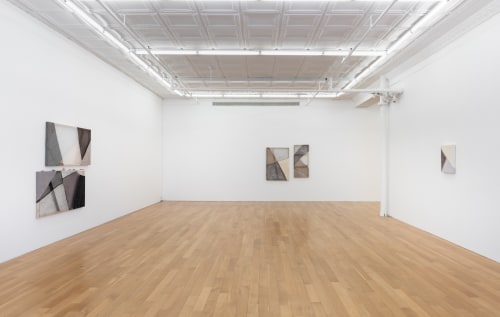
Martha Tuttle: "Touch / Stone"
By Tom McGlynn
May 1, 2024
For her inaugural show at Peter Blum, Martha Tuttle presents an array of paintings in conjunction with the subtle sculptural presence of a variety of rocks and crystals, both within these and distributed discreetly throughout the gallery. Her wall works are not what one would traditionally be considered paintings, since they are formed from woven wool and silk often dyed with organic minerals, orchestrating levels of opacity and transparency which play hide and seek with their stretcher bar supports. Tuttle invites one to recalibrate one’s idea of painting to include a broader definition of what I’d term “lateral sculpture,” or how painting is always a thing irrevocably wedded to its image/symbol pictorial register. Importantly weighing painting in the direction of its objecthood, she sets up a cognitive dissonance between one’s expectations of wall works (traditionally maintaining a more passive relation to the viewer) and the ostensibly more aggressive claim on one’s attention by sculpture. Over the course of her career, she has emphasized how the universality of the material world is a continuum of experience and that her work is analogous to that cosmological continuum, so a muddying of categorical distinctions between media essentially grounds her work in such a presumption. As it does here, her approach sets up its own paradigm of mediation, refreshing the phenomenological encounter called “art.”
Tuttle maintains a very intimate relation to the materiality of her work. She spins and weaves her own wool and sews her silk sections, elements which partially comprise her paintings. These fabrics are then dyed with rocks, minerals, and plant matter that she grinds herself into pigment solutions. This back-to-basics ethic in her work process aligns with her oft-stated intention that close care correlates with empathic embodiment, and she’s referred in the past to her stitched planes as a relation of “skins” to stretcher bar “skeletons.”1 In this show, Portrait of a loved one getting older (2024) evokes a sense of human frailty and mortality, as its wooden and aluminum support can be seen through its transparent and opaque passages of dyed silks sensitively stitched together so that the inside seam (looking like an interior of a French seam) bends in serpentine improvisation according to its position, weight, and tension within its given matrix. Here a smaller square stretcher extends from the larger one, dyed progressively darker, counterpoised with a burnt wood angle leaning away in the larger square. Trending more opaquely is Personal Routine (2024), a single vertical rectangle made of wool, silk, and linen sewn into three interlocking wedge shapes, its simplicity seeming to echo its titular confidential order.
A relation to specific landscapes is something that characterizes Tuttle’s practice, and this is made manifest in two complex works, entitled Sediment accumulating in the bend of a river and seeing water through thin ice in early springtime (both 2024). She has credited her early experience of growing up in rural New Mexico with this material of place relation, and that austerely beautiful, yet sometimes elementally unforgiving, landscape could well be extrapolated, in her fabric shards, from memories of flash flood-worn arroyos and sun-cracked chaparrals. The dyeing on the silk in particular takes on an offhand “dirty” aspect which effectively alludes to such natural processes, as do some charred wood support structures peeking through. Actual stones and crystals are distributed, seemingly randomly, both along their support perimeters and inside of them, putting a finer point on concepts of sedimentation and the elemental transformation between fluid and more durable form. There’s a lurking alchemy at work here, yet kept thankfully free of determinist goals of reduction to esoteric theory. One thinks of Smithson’s rocky Non-Site transferences of specific places to “White Cube” contexts and how such a recontextualization obviated long-held distinctions between aesthetics and the earth sciences.
Tuttle’s configurations are often made up of diptych panels in skewed relation, creating an indeterminate balance that further “faults” their reading as traditional paintings. She shares her poetic reimagining of the medium with slightly older artists such as Sarah Crowner and Sam Moyer, who stitch and hew their works, respectively, from fabric and stone. Yet Tuttle is more of a quirky and lyrical post-Minimalist, a quality she shares with her father, Richard Tuttle, though she has said in past interviews that her poet mother, Mei-mei Berssenbrugge, may have exerted a stronger influence. This in her poetic appeal to the micro/macro world interface handed down from the American Transcendentalist movement (by way of a confluence of Euro-Asian philosophy). Consider this excerpt from Berssenbrugge’s poem “Hello, the Roses”: “My soul radially whorls out to the edges of my body, according to the same laws / by which stars shine, communicating with my body by emanation.”2 Emerson’s “transparent eyeball” floats in somewhere around here, with its analogy of one’s elemental absorption of nature rather than its reasoned reflection. It’s telling to note the overall limpidity of Tuttle’s veils of materiality within such a tradition of existential permeability.
The combined effect of the clarifying installation of Tuttle’s work in Blum’s gallery is of an episodic tilting and rebalancing upon stepping stones beckoning across a river. Larger works like the diptychs aforementioned are given a wide berth with smaller works dispersed in both wide and close spacing between, creating an arrhythmic pulse appropriate to the artist’s atypical material and mode of making paintings. A similar array of stones and crystals are distributed discretely throughout the gallery. The offhand nature of their distribution might seem arbitrary (these are not listed as specific works in the gallery list), but they do relate to the scatter statements the artist has made, with both found and cast stone, in previous exhibitions, as in her 2020 installation entitled Outlooks at Storm King Art Center in upstate New York. Here the place is obviously a human-made environment, but an indeterminate play between human construction and natural inevitability is one of Tuttle’s most essential qualities.